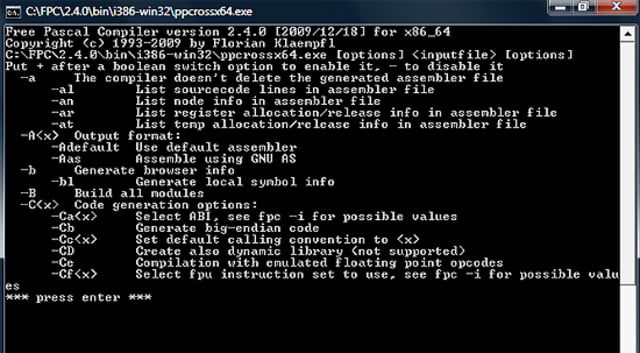The Birth of Pascal: An Educational Language
- 1970: Niklaus Wirth developed Pascal at ETH Zurich as a teaching language.
- Designed with a focus on structured programming, modularity, and type checking.
- Widely used in university courses to introduce programming concepts.
Early Applications

- 1970s-1980s: Pascal gained popularity in business and scientific applications.
- Used for developing database systems, compilers, and numerical analysis software.
The Rise of Object-Oriented Programming

- Late 1980s-Early 1990s: Object-oriented programming (OOP) emerged as a dominant paradigm.
- Pascal struggled to keep up with OOP advancements due to its original design.
Delphi and Lazarus: Pascal Revived
- 1995: Borland released Delphi, an integrated development environment (IDE) that extended Pascal with OOP capabilities.
- Delphi gained popularity for rapid application development (RAD).
- Lazarus, an open-source Delphi alternative, was released in 1999.
Modern Pascal Implementations
- Free Pascal: A free and cross-platform Pascal compiler.
- Delphi XE: Borland’s latest IDE that supports both Pascal and other languages.
- PascalABC.NET: A .NET-based Pascal compiler for rapid prototyping and teaching.
Applications of Modern Pascal
- Cross-platform desktop applications (Windows, macOS, Linux)
- Mobile applications (via platforms like Delphi FireMonkey)
- Embedded systems (using compilers like SDCC)
- Web development (via web frameworks like Web.Pascal)
Advantages of Pascal
- Strong type system and memory management
- Emphasis on structured programming and code clarity
- Improved OOP support through extensions like Delphi
- Cross-platform compatibility
- Active and supportive community
Disadvantages of Pascal
- Not as widely known or used as languages like Python or JavaScript
- Can be more verbose for simple tasks compared to modern languages
- Lack of advanced language features found in newer languages
Conclusion
Pascal has evolved from an educational language to a versatile programming tool with a wide range of applications. While it may not be as popular as some newer languages, its emphasis on structured programming, strong typing, and cross-platform compatibility make it a viable option for a variety of software development tasks.## The Evolution of Pascal: From Education to Application
Executive Summary
Pascal, a high-level programming language designed by Niklaus Wirth in 1968-1969, has undergone significant evolution over the years. Initially developed for educational purposes, Pascal has found widespread applications in various domains. This comprehensive article explores the journey of Pascal, highlighting its origins, key subtopics, and the factors that have contributed to its continued relevance.
Introduction
Pascal, named after the renowned French mathematician and philosopher Blaise Pascal, was conceived as a teaching tool to introduce students to the fundamental concepts of computer science. Its structured syntax and emphasis on data typing made it an ideal choice for educational settings. Over time, Pascal evolved into a versatile programming language with applications spanning operating systems, compilers, and scientific computing.
FAQs
What is Pascal?
Pascal is a general-purpose, imperative programming language known for its structured design, data typing system, and readability.
What are the benefits of using Pascal?
Pascal offers several advantages, including:
- Structured syntax that enhances code readability and maintainability
- Strong data typing that reduces errors and improves code reliability
- Portability across different platforms
- Availability of a wide range of development tools and libraries
What are the limitations of Pascal?
One potential limitation of Pascal is its slower execution speed compared to some other programming languages. Additionally, its relatively limited support for object-oriented programming can be a drawback for certain types of applications.
Subtopics
Syntax
Pascal’s syntax is characterized by its structured and modular approach. Key features include:
- Reserved words: Specifies the language’s keywords, such as “begin” and “end.”
- Data types: Defines various data types to represent different kinds of data, such as integers, real numbers, and strings.
- Control structures: Enables the flow of execution through statements such as “if-then-else” and “for” loops.
- Procedures and functions: Allows for code modularity and reuse.
Data Structures
Pascal supports various data structures to organize and manipulate data effectively. Some important ones include:
- Arrays: A collection of elements of the same type that are accessed using an index.
- Records: A user-defined data type that groups related data elements.
- Sets: A collection of unique elements that can be used for mathematical operations.
- Linked lists: A dynamic data structure that stores data elements in a linear order.
Object-Oriented Programming
Although not originally designed for object-oriented programming (OOP), Pascal has been extended to support OOP concepts. Key aspects include:
- Classes: Blueprints for creating objects.
- Objects: Instances of classes that encapsulate data and behavior.
- Inheritance: The ability for subclasses to inherit properties and methods from parent classes.
Compilers
Pascal compilers are essential for translating Pascal source code into machine code. Some notable compilers include:
- Turbo Pascal: A popular compiler known for its speed and ease of use.
- Free Pascal: An open-source compiler that supports multiple platforms.
- GNU Pascal: A compiler that is part of the GNU Compiler Collection (GCC).
Applications
Pascal has been used in a wide range of applications, including:
- Operating systems: Early versions of Mac OS and AmigaOS were written in Pascal.
- Compilers: Pascal has been used to develop compilers for other languages, such as C and Java.
- Scientific computing: Applications in areas like numerical analysis and simulations.
- Educational tools: Pascal continues to be used in educational settings to teach programming concepts.
Conclusion
The evolution of Pascal from an educational tool to a versatile programming language has been remarkable. Its structured syntax, data typing system, and support for various data structures make it a valuable choice for a wide range of applications. While its object-oriented programming capabilities are somewhat limited, Pascal remains a relevant language in certain domains, such as operating systems development and scientific computing. As technology continues to advance, the legacy of Pascal will likely continue to influence the development of programming languages and applications.
Keyword Tags
- Pascal
- Programming Language
- Data Structures
- Object-Oriented Programming
- Applications

